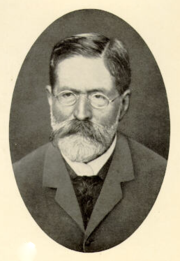
Ernst Ludwig Alfred Hegar
Encyclopedia

Germany
Germany , officially the Federal Republic of Germany , is a federal parliamentary republic in Europe. The country consists of 16 states while the capital and largest city is Berlin. Germany covers an area of 357,021 km2 and has a largely temperate seasonal climate...
gynecologist famous for developing new medical tools and techniques. He was born January 6, 1830 in Darmstadt
Darmstadt
Darmstadt is a city in the Bundesland of Hesse in Germany, located in the southern part of the Rhine Main Area.The sandy soils in the Darmstadt area, ill-suited for agriculture in times before industrial fertilisation, prevented any larger settlement from developing, until the city became the seat...
, Germany and died August 5, 1914. He was buried in Breisgau
Breisgau
Breisgau is the name of an area in southwest Germany, placed between the river Rhine and the foothills of the Black Forest around Freiburg im Breisgau in the state of Baden-Württemberg. The district Breisgau-Hochschwarzwald, which partly consists of the Breisgau, is named after that area...
.
Hegar was the son of Johann August Hegar (1794-1882), a country Doctor. He studied medicine in Giessen, Heidelberg
Heidelberg
-Early history:Between 600,000 and 200,000 years ago, "Heidelberg Man" died at nearby Mauer. His jaw bone was discovered in 1907; with scientific dating, his remains were determined to be the earliest evidence of human life in Europe. In the 5th century BC, a Celtic fortress of refuge and place of...
, Berlin
Berlin
Berlin is the capital city of Germany and is one of the 16 states of Germany. With a population of 3.45 million people, Berlin is Germany's largest city. It is the second most populous city proper and the seventh most populous urban area in the European Union...
and Vienna
Vienna
Vienna is the capital and largest city of the Republic of Austria and one of the nine states of Austria. Vienna is Austria's primary city, with a population of about 1.723 million , and is by far the largest city in Austria, as well as its cultural, economic, and political centre...
, and after graduation went into the army and worked as military physician. He later went into private practice as an obstetrician in the city of Darmstadt
Darmstadt
Darmstadt is a city in the Bundesland of Hesse in Germany, located in the southern part of the Rhine Main Area.The sandy soils in the Darmstadt area, ill-suited for agriculture in times before industrial fertilisation, prevented any larger settlement from developing, until the city became the seat...
.
Alfred Hegar was chosen to be the successor of Otto Spiegelberg
Otto Spiegelberg
Otto Spiegelberg was a German gynecologist who was a native of Peine.He studied medicine at the University of Göttingen, and afterwards furthered his studies in Berlin, Prague and throughout the United Kingdom. In 1851 he earned his medical doctorate, and was habilitated at Göttingen in 1853...
as professor for gynecology and obstetrics at the University of Freiburg
University of Freiburg
The University of Freiburg , sometimes referred to in English as the Albert Ludwig University of Freiburg, is a public research university located in Freiburg im Breisgau, Baden-Württemberg, Germany.The university was founded in 1457 by the Habsburg dynasty as the...
in 1864 and was the first head of the Universitäts-Frauenklinik of the University Medical Center Freiburg
University Medical Center Freiburg
The University Medical Center Freiburg in Freiburg, Germany is the teaching hospital and part of the medical research unit of the University of Freiburg and home to its Faculty of Medicine. The medical center is one of the largest and most reputable in Europe, due to its extensive clinical...
when it opened in 1868. Hegar also founded the journal "Beiträge zur Geburthilfe und Gynäkologie" in 1898. He was a pioneer of antiseptics and antiseptic
Antiseptic
Antiseptics are antimicrobial substances that are applied to living tissue/skin to reduce the possibility of infection, sepsis, or putrefaction...
procedures. Hegar retired in 1904.
Among the many techniques and instruments he developed were Hegar's sign
Hegar's sign
Hegar's sign is a non-sensitive indication of pregnancy in women — its absence does not exclude pregnancy. It pertains to the features of the cervix and the uterine isthmus....
and Hegar's dilator, as well as Hegar's operation, an operation for repairing a ruptured perineum. His works are still widely discussed at colleges of obstetrics worldwide.

